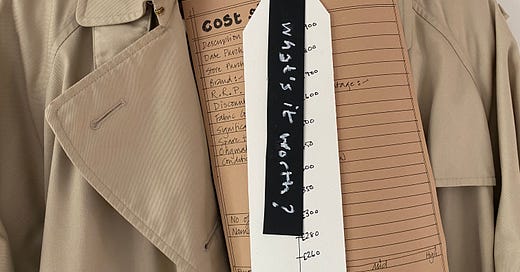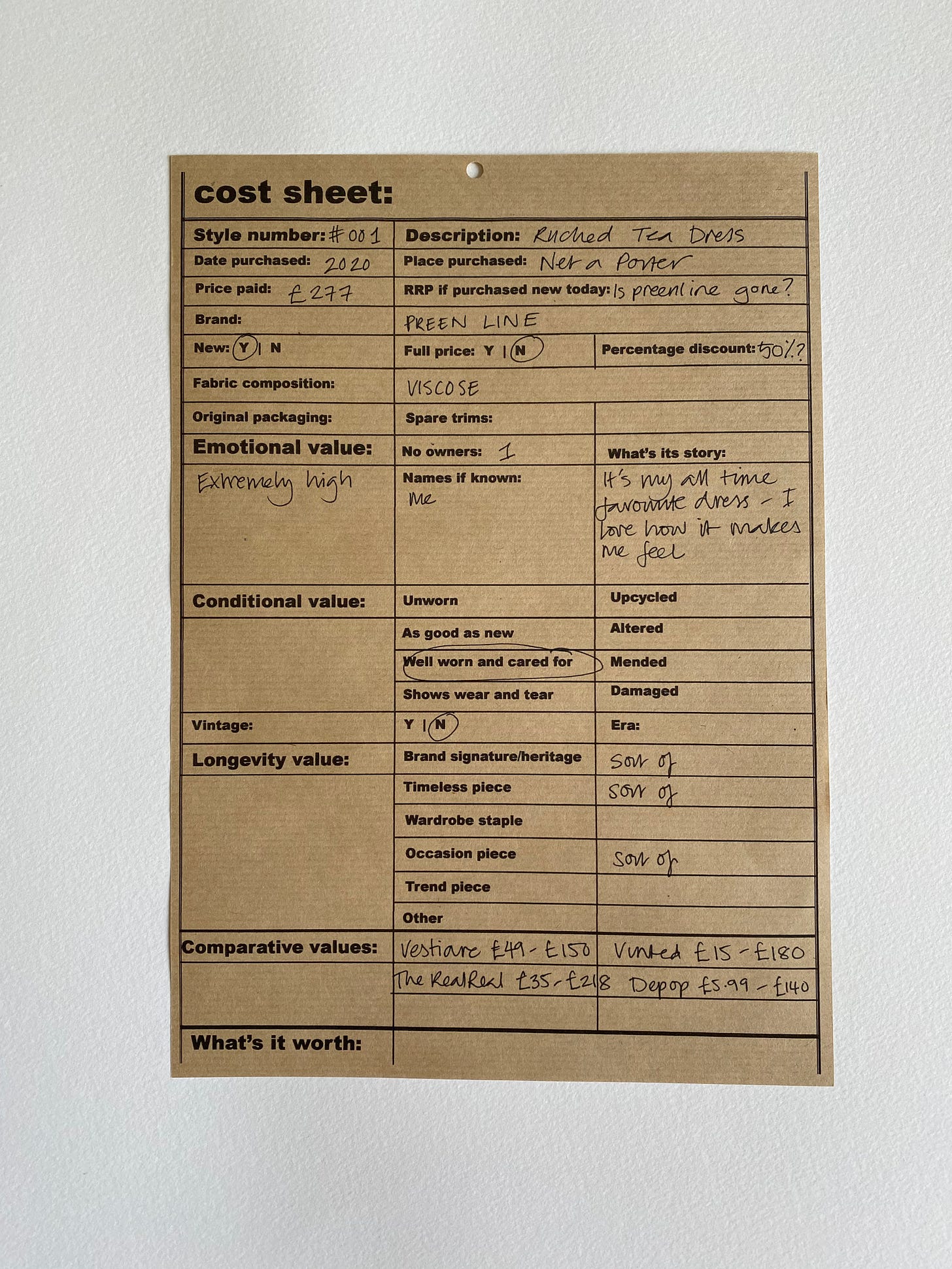What would you pay for my old clothes?
Prices in the secondhand market are inconsistent and highly subjective. To find out more I designed a series of experiments asking what my 'much loved' clothes are worth? This is what I learned....
Prices in the secondhand market are notoriously inconsistent
At the end of last summer, as part of my MA Fashion Futures research, I ran a series of experimental pop-ups and instagram posts designed to explore value and values in secondhand fashion resale market. Primary research interviews, conducted with people working inside secondhand fashion businesses, and charities, in the UK had revealed that values in the secondhand market are very inconsistent.
Prices are set by individuals, or algorithms, who believe they know what we’re prepared to pay for preloved apparel; making judgements about the value of used clothing based on brand, quality, condition, utility, our postcodes and our disposable income.
My research also highlighted an essential tension between buyers, who want to “treasure hunt” and find undervalued bargains, and resellers who seek to maximise resale values and may significantly overestimate the value of their own preloved (once much loved) apparel.
I wanted to learn more…
So what are my old clothes worth?
The title of my experiments “What’s it worth?” was deliberately provocative. I took a carefully curated selection of my own clothes and asked people what they thought they were worth in the secondhand market. The pieces ranged from high street to designer, from the 1980’s to the 2020’s, some were bought new and some were purchased secondhand, some were in perfect condition, some were well worn, some were upcycled and some were repaired.
Participants were asked to say what they thought ten items were worth and to list the criteria they used for their valuations.
As my primary research suggested curation, provenance and storytelling in physical secondhand stores might significantly increase the prices people were prepared to pay for preloved apparel and I also wanted to test this theory. For the first experiment I created an emotional cost sheet that was attached to each garment, sharing its history, the price I paid for it, what it would cost to buy new today, and my personal opinions on its value and longevity. As a control these sheets were removed in a second pop-up and people valued the clothes with no additional information.
What did I learn?
Brands really do matter in the secondhand market!
The ability to buy brands that are unaffordable new is often flagged as a motivation for shopping secondhand and “brand” was cited as the second most important consideration by participants when they were valuing items.
What's interesting is that “big” brand awareness, and the pervasive influence of mainstream fashion brand marketing, did seem to significantly inflate the values people gave some of the pieces. In both the pop-ups people the Burberry trenchcoat and the Gucci shirt were recognised as “expensive” and “good quality” brands and priced highly.
Whereas many people priced the jeans from E.L.V. Denim, a less well known brand, in comparison to the price of secondhand jeans generally - considerably reducing their value.
Storytelling and provenance add value
In the second pop-up, where I omitted the emotional cost cards, the valuations people gave were generally lower. This depreciation was particularly marked in relation to the vintage Chloe top and the Boss jacket where the stories told about the garments appear to have inflated their value considerably, whereas the value of the Burberry trench coat remained relatively consistent.
We’ll pay more for preloved clothes we can touch and try on
People told me they were nervous of purchasing secondhand clothing online. They worried about whether it would fit them, whether it would look good on them and whether it would arrive in the condition as described. This showed in the valuations, and comments, given on by the participants on instagram.
Being able to touch and try clothes on, in combination with storytelling added value - “£80 if I could try it on, £50 if I bought it online”
This raises interesting questions around whether the growth of online resale platforms like Vinted are reducing the prices we’re prepared to pay for secondhand clothes? What do you think?
People value quality and longevity
Items that hold value in the secondhand market through multiple lifecycles are generally perceived to be good quality and relatively timeless, like Levis jeans, Carhartt workwear or Chanel bags. For the participants in the values experiments, ‘longevity’ was the third most important consideration, after quality and brand.
This suggests there could be an opportunity for the secondhand market to differentiate itself from the mainstream market’s obsession with seasonal trends and discounting and develop its own value system based on quality and longevity.
Mending matters
The mended items really polarised opinions. Some people thought mending added value, some people wouldn’t buy mended items, many secondhand retailer wouldn’t sell anything mended, and some people would buy something damaged but only if they could mend it themselves.
If we want to keep clothes in use for longer as part of strategies to reduce fashion’s emissions then this research suggests ‘mending’ needs a makeover and some clever marketing to make it desirable and aspirational.
The overall results…
What did I conclude?
That online resale may not be the best way to maximise the value and reuse potential of secondhand apparel.
Instead of following the mainstream industry, and focusing on digital growth, there could be opportunities for the secondhand market to reinvent retailing for the 21st century as a route to adding value to secondhand clothes through curation, presentation and storytelling.
Given the importance of quality to secondhand shoppers the declining quality standards in the mainstream fashion industry coupled with the increase in fast fashion consumption could seriously impact the viability and growth of the secondhand market in the future.
What did I miss?
What’s next
I’m delighted to say Reskinned have invited me to bring my “what’s it worth?” experiment to the Blue Earth Summit in London on the 16th and 17th of October - if you’re there please come and tell me what my clothes are worth…
And I’ll also be sharing the experiment at the next “Is Fashion’s Future Secondhand?” panel discussion I’m hosting on the 17th of October at The Lab E20.
The panellists are Joshua Bond aka Always in Vintage, Sol Escobar founder of Give Your Best, Eliza Lau Johnston aka Twenty Outfits, Sue Poole aka Mamma See Mamma Do and Zoe Sussmeyer founder of The Big Swap Events. Please do come along and tell us what you think - tickets are free on Eventbrite here.
Subscribe now to find out what this next phase of this experiment reveals…






A good label like Burberry will always hold its value. A ‘used clothes’ store will need to seriously differentiate itself from charity shops if the garments are to hold their price. Having said that prices are increasing in charity shops. A lot there to think about. Unfortunately will miss discussion as will be working. Look forward to hearing about it on insta. Linda
This is genius. I'm so excited to integrate this research into my advice for clients (I'm the email strategist and copywriter you met at Blue Earth Summit who was wearing head-to-toe Reskinned Finisterre).